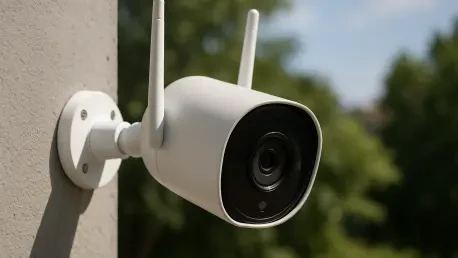Imagine a world where home security is no longer tethered to complex wiring or restricted by property layouts—a reality where safeguarding a residence is as simple as placing a device on a shelf or mounting it outdoors, and wireless security cameras have made this vision an accessible solution for millions. They address the rising need for flexible, user-friendly protection in an era of increasing property crimes. This review dives deep into the technology behind these innovative devices, exploring their features, performance, and role in modern smart home ecosystems, while providing a clear perspective on their strengths and limitations for homeowners, renters, and small business operators alike.
Understanding the Rise of Wireless Security Solutions
Wireless security cameras have emerged as a cornerstone of smart home technology, offering battery-powered, wire-free designs that prioritize ease of installation and adaptability. Unlike traditional wired systems, these devices require no drilling or permanent fixtures, making them an ideal choice for those in temporary living situations, such as renters or apartment dwellers, who often face restrictions on modifying their spaces. Their ability to function without cords allows placement in a variety of locations, from doorways to backyards, ensuring comprehensive coverage with minimal effort.
The surge in demand for such hassle-free security options reflects a broader shift toward convenience in consumer electronics. These cameras cater to a growing audience seeking effective monitoring without the technical barriers associated with older systems. Their integration into the smart home landscape further amplifies their appeal, connecting seamlessly with mobile apps and other devices to provide real-time alerts and remote access, thus enhancing both safety and peace of mind for users across diverse demographics.
In-Depth Analysis of Features and Performance
Unmatched Convenience Through Wire-Free Design
A defining characteristic of wireless security cameras lies in their cordless construction, eliminating the need for intricate wiring setups. This feature enables users to position cameras in challenging or remote spots, whether indoors on a high shelf or outdoors overlooking a garden, without worrying about proximity to power outlets. Models like the Blink Outdoor 4 exemplify this flexibility, offering straightforward mounting options that appeal to novices and seasoned tech enthusiasts alike.
The simplicity of installation further enhances their attractiveness. Most devices come with intuitive guides and minimal hardware, often requiring just a few minutes to set up through a companion app. This accessibility ensures that even those unfamiliar with technology can secure their premises without professional assistance, democratizing home surveillance and making it a viable option for a wide range of households and small businesses.
Battery Longevity and Sustainable Power Innovations
Advancements in battery technology have significantly improved the operational duration of these cameras, addressing early concerns about frequent recharges. High-performing models, such as the Ring Outdoor Camera Pro and Swann MaxRanger 4K Solar, can last several months on a single charge under optimal conditions, reducing maintenance demands for users. This extended lifespan is particularly beneficial for outdoor placements where access for recharging might be inconvenient.
Incorporation of renewable energy solutions, like solar panel attachments, marks a notable trend in enhancing power efficiency. The Swann MaxRanger 4K Solar, for instance, leverages solar energy to sustain operation, minimizing environmental impact while alleviating concerns over battery depletion. Such innovations reflect a growing consumer preference for sustainable technology, positioning these devices as forward-thinking choices in the security market.
Video Resolution and Advanced Functionalities
Video quality remains a critical metric for evaluating wireless security cameras, with resolutions ranging from standard 1080p to cutting-edge 4K. While the Ring Outdoor Camera Pro and Blink Outdoor 4 deliver 1080p footage suitable for smaller properties, the Swann MaxRanger 4K Solar offers superior clarity and a wide 105-degree viewing angle, ideal for monitoring expansive areas. This variation allows consumers to select a device aligned with their specific coverage needs.
Beyond resolution, additional features elevate the utility of these cameras. Color night vision, as seen in Ring models, ensures clear visuals in low-light conditions, while custom motion zones in Blink cameras enable tailored alert settings to reduce false notifications. Swann’s heat-based detection further refines accuracy by distinguishing between human activity and irrelevant triggers, providing users with precise security solutions customized to their environments.
Market Trends Shaping Wireless Security Technology
The smart home industry has increasingly gravitated toward wireless, battery-powered devices, driven by a collective desire for adaptability and minimal setup complexity. This shift underscores a preference for systems that can be easily relocated or scaled up, catering to dynamic lifestyles and living arrangements. As a result, manufacturers continue to prioritize portability and user-centric designs in their product development.
Sustainability has also become a focal point, with solar integration gaining traction as a practical power alternative. This trend aligns with broader environmental consciousness among consumers, who value technologies that reduce reliance on disposable batteries or constant grid energy. The adoption of such eco-friendly options signals a maturing market responsive to both functional and ethical considerations.
Debates surrounding subscription models persist, shaping purchasing decisions significantly. While some brands, like Ring, lock advanced features behind paid plans, others, such as Blink and Swann, offer local storage alternatives to bypass recurring costs. This dichotomy highlights an ongoing tension between accessibility and premium functionality, influencing how consumers evaluate long-term value in their security investments.
Practical Applications Across Diverse Settings
Wireless security cameras find utility in a multitude of scenarios, from residential homes to small commercial spaces, accommodating both indoor and outdoor surveillance needs. Their weather-resistant builds ensure durability against elements, making them suitable for monitoring entry points, perimeters, or interior rooms. This versatility addresses a wide spectrum of security concerns with a single type of device.
Specific models cater to distinct user profiles effectively. The Blink Outdoor 4 serves as an entry-level option for budget-conscious individuals or first-time buyers, providing essential monitoring at an affordable price point. Meanwhile, the Ring Outdoor Camera Pro offers a balanced mid-range solution with enhanced features for varied needs, and the Swann MaxRanger 4K Solar targets those requiring high-end outdoor surveillance with detailed 4K imagery and expansive coverage.
Unique applications further demonstrate their adaptability. For instance, Swann’s heat detection and broad viewing capabilities make it an excellent choice for large properties or rural settings where pinpointing specific threats is crucial. Such specialized use cases illustrate how these cameras transcend basic protection, offering tailored solutions for niche security challenges.
Navigating Challenges and Limitations
Despite their advancements, wireless security cameras face certain technical hurdles that impact performance. Low-light conditions often reveal shortcomings, such as grainy footage in budget models like the Blink Outdoor 4, necessitating careful placement or additional lighting for optimal results. Users must also balance video settings with battery conservation to avoid rapid power drain, a trade-off that requires active management.
Market-related obstacles, particularly subscription costs, pose barriers for some consumers. Devices like the Ring Outdoor Camera Pro mandate paid plans for full access to cloud storage and advanced alerts, potentially alienating those seeking cost-effective options. This financial consideration often influences buyer preferences, pushing demand for alternatives with free-tier features or local storage capabilities.
Efforts to address these limitations are underway, with manufacturers exploring improved low-light sensors and more efficient power usage in newer iterations. The provision of local storage by brands like Blink and Swann represents a direct response to subscription concerns, ensuring users have viable choices. These ongoing improvements suggest a commitment to refining user experience and broadening market appeal over time.
Envisioning the Future of Home Surveillance
Looking ahead, wireless security cameras are poised for transformative advancements, particularly through the integration of artificial intelligence for smarter motion detection. Enhanced algorithms could distinguish between routine activities and genuine threats with greater accuracy, reducing unnecessary alerts and refining security responses. Such developments promise to elevate the intelligence of these systems significantly.
Battery technology is another area ripe for innovation, with potential for even longer-lasting power sources or faster recharging methods. Coupled with broader adoption of subscription-free models, this could lower the overall cost of ownership, making advanced security accessible to a wider audience. Greater compatibility with diverse smart home platforms also looms on the horizon, fostering seamless ecosystem integration.
The long-term impact on home security appears profound, with these devices likely to become standard fixtures in personal safety and property protection. As technology evolves, their role may expand beyond mere surveillance to proactive threat prevention, reshaping how safety is perceived and managed in everyday life. This trajectory underscores their growing importance in an increasingly connected world.
Reflecting on the Evaluation Journey
Looking back, the assessment of wireless security cameras revealed their remarkable reliability and accessibility across a spectrum of budgets, as demonstrated by models like Ring, Blink, and Swann. Their evolution into viable alternatives to wired systems stood out, with notable strides in battery endurance and ease of use marking significant progress. Each device brought distinct strengths to the table, catering to varied user needs with a blend of innovation and practicality.
Moving forward, consumers are encouraged to weigh specific priorities—be it video clarity, cost, or subscription independence—when selecting a camera. Exploring local storage options or solar integrations could mitigate ongoing expenses, while staying informed about emerging AI enhancements might offer future-proofing benefits. As the technology continues to advance, engaging with manufacturer updates and community reviews will ensure decisions remain aligned with the latest capabilities and solutions.









